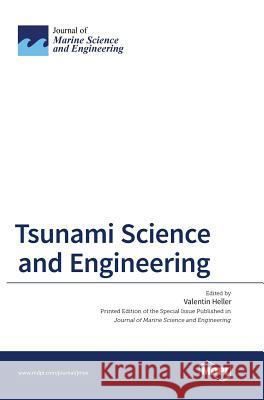Tsunami Science and Engineering » książka
Tsunami Science and Engineering
ISBN-13: 9783038422334 / Angielski / Twarda / 2016 / 330 str.
JMSE Special Issue: Tsunami Science and Engineering Recent earthquake-tsunamis including the 2004 Indian Ocean Tsunami, with over 230,000 casualties, and the 2011 T hoku Tsunami in Japan, with over 18,500 people missing or dead, serve as tragic reminders that such waves pose a major natural hazard to human beings. Landslide-tsunamis, including the 1958 Lituya Bay case, may exceed 150 m in height and if similar waves are generated in lakes or reservoirs (so-called impulse waves), then they may overtop dams and cause significant devastation downstream, such as in the 1963 Vaiont case with around 2,000 casualties. The after-effects due to such catastrophes are not limited to the region immediately impacted by the wave; for example, the 1963 Vaiont case affected hydropower plant planning and management globally and the 2011 T hoku Tsunami initiated changes to nuclear power plant policies worldwide.
Active prevention of the wave generation is extremely unlikely and limited to rare cases where creeping slides could be stabilized. Scientists and engineers thus work mainly on passive methods to face this hazard. In many cases, the propagation time between generation and shoreline is sufficiently long, allowing early warning systems for evacuation to be an effective passive method. For impulse waves in smaller water bodies, however, the propagation time is too short for an adequate evacuation so further passive methods are critical. Such methods include sea walls, reinforced infrastructure and the provision of adequate freeboards of dam reservoirs. These methods require detailed knowledge of (i) the wave features as a function of the generation mechanism, (ii) the shoreline run-up and (iii) the interaction with structures.
Despite a significant increase in research activities after the 2004 Indian Ocean Tsunami, there certainly can be -- and needs to be -- more research with the aim to reduce the destruction caused by tsunamis to us and our environment. "
JMSE | Special Issue : Tsunami Science and EngineeringRecent earthquake-tsunamis including the 2004 Indian Ocean Tsunami, with over 230,000 casualties, and the 2011 Tōhoku Tsunami in Japan, with over 18,500 people missing or dead, serve as tragic reminders that such waves pose a major natural hazard to human beings. Landslide-tsunamis, including the 1958 Lituya Bay case, may exceed 150 m in height and if similar waves are generated in lakes or reservoirs (so-called impulse waves), then they may overtop dams and cause significant devastation downstream, such as in the 1963 Vaiont case with around 2,000 casualties.The after-effects due to such catastrophes are not limited to the region immediately impacted by the wave; for example, the 1963 Vaiont case affected hydropower plant planning and management globally and the 2011 Tōhoku Tsunami initiated changes to nuclear power plant policies worldwide.
Active prevention of the wave generation is extremely unlikely and limited to rare cases where creeping slides could be stabilized. Scientists and engineers thus work mainly on passive methods to face this hazard. In many cases, the propagation time between generation and shoreline is sufficiently long, allowing early warning systems for evacuation to be an effective passive method. For impulse waves in smaller water bodies, however, the propagation time is too short for an adequate evacuation so further passive methods are critical. Such methods include sea walls, reinforced infrastructure and the provision of adequate freeboards of dam reservoirs. These methods require detailed knowledge of (i) the wave features as a function of the generation mechanism, (ii) the shoreline run-up and (iii) the interaction with structures.
Despite a significant increase in research activities after the 2004 Indian Ocean Tsunami, there certainly can be — and needs to be — more research with the aim to reduce the destruction caused by tsunamis to us and our environment.











